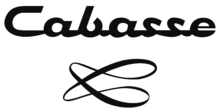Cabasse (company)
Cabasse is a French audio manufacturer founded by Georges Cabasse (1928-2019[1]) in 1950. It is mainly known for its home loudspeakers but has also produced professional audio speakers for studio recording or sound reinforcement in theatres and power amplifiers.
 | |
| Private | |
| Industry | Consumer electronics |
| Founded | 1950 |
| Headquarters | Plouzané, France |
Key people | Jean-Yves Bouvet-Maréchal Chairman |
| Products | Loudspeakers |
| Website | www.cabasse.com |
.jpg)
Important dates
- 1950 : Foundation.
- 1952 : First 2-way coaxial speakers for Cinemascope movie theatres like Le Grand Rex in Paris.
- 1958 : First active loudspeakers systems with valve amplifiers and filters.
- 1965 : Underwater loudspeakers for the French Navy.
- 1974 : Dome tweeters and midranges, servo-controlled active Hi-Fi and monitor loudspeakers (used by Radio France).
- 1983 : Honeycomb dome membranes for Hi-Fi and Public Address systems, from 7" to 22".
- 1984 : Carbo high-efficiency units for the 4 way clusters fitting the 12-channel system at the Omnimax theatre La Géode in Parc de la Villette, Paris.
- 1985 : Duocell membranes based on an exclusive processing of Rohacell foam.
- 1992 : The SCS principle (Spatially Coherent System) launched with the Atlantis reference system (4 channel and 5 speakers : 2 woofers and a 3 way coaxial speaker called TC21 that goes from 200 Hz to 20 kHz).
- 1998 : Fitting of the Charles de Gaulle aircraft carrier with specific 117 dB efficiency horn systems.
- 2002 : The TC22 reference 3 way coaxial unit, that goes from 80 Hz to 20 kHz.
- 2006 : La Sphere, a 4 way coaxial unit is launched.
- 2006 : Cabasse is bought by Canon Europe and was led by Kazuhiro Otsubo, president of the Canon factory in Brittany.
- 2014 : Start up group Awox buys Cabasse from Canon.[2]
Notable products and technologies
Cabasse is one of the oldest loudspeakers manufacturer in France, and is known for its involvement in research, its high standard of quality, and the names of their products that used to be related to sea (especially boat names like clipper, sampan, ketch, sloop...)
In the eighties their reputation came from their professional active speakers (often used by recording studios) and the honeycomb membranes that allowed high power with low distortion. These membranes were used by the very small Galiote (home hi-fi) and the huge Saturn, a subwoofer for theatres, fitted with a 22 inches unit. They also used to perform astounding comparisons between live sound and speakers sound and therefore focused their goals on high dynamics (for real sound pressure levels), high efficiency and low distortion levels.
In 1986 La Géode was inaugurated, and it remains the only 12-channel Omnimax in the world. For special low frequency effects, 4 giant subwoofers (100 cubic feet for 2000 lb) fitted with 2 x 22 inches honeycomb membranes complement this 12.6 system.[3]
In the nineties, Cabasse started to work on coaxial units in order to reduce directivity through spherical wavefront. This is their Spatially Coherent System principle. It was implemented through the TC21, a 3-way coaxial unit whose bandwidth goes from 200 Hz to 20 kHz with a 30° off-axis response very close to the on-axis response.
At the beginning of 2006 they unveiled a high-end 4-way unit and presented the theoric approach in a paper at the Audio Engineering Society. This system, released in 2007, is called La Sphère and consists of two spheric coaxial speakers, a filter and four power amplifiers.
References
- www.cabasse.com
- "Archived copy". Archived from the original on 2015-06-19. Retrieved 2015-06-19.CS1 maint: archived copy as title (link)
- "Archived copy". Archived from the original on 2014-08-23. Retrieved 2017-03-16.CS1 maint: archived copy as title (link)